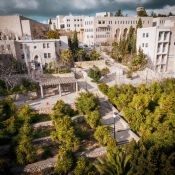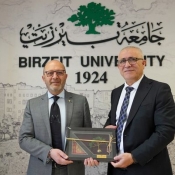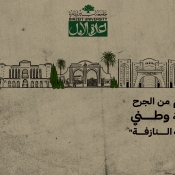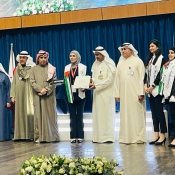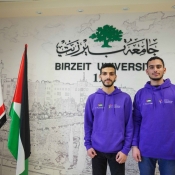Paul Hobson, of Modern Art Oxford, bolsters ties with Birzeit in museum visit
Paul Hobson, director of Modern Art Oxford, one of the UK’s most prominent art galleries, has recently explored the collections housed at the Birzeit University Museum in a visit to the university campus on Tuesday, August 3, 2021.
Hobson, who has been leading Modern Art Oxford since 2013, met with Dr. Tina Sherwell, director of the Bachelor’s Program in Contemporary Visual Art at Birzeit University, who showcased artworks created by the graduating students as their capstone projects — part of an ongoing cooperation between the program and the Birzeit University Museum.
The compositions, noted Sherwell, were created by the students as expressions of their most personal experiences, with some artworks depicting the forced isolation brought about by the COVID-19 pandemic and its concurrent lockdowns, and others exploring society’s expectations of the female body and how these views interact and clash with, oftentimes common, skin conditions.
After he toured the student installations, Hobson met with Dr. Nazmi Al Jubeh, director of the Birzeit University Museum, who gave a brief overview of the institution, its goals, and art collections. The museum, Al Jubeh, explained, is an interactive art platform that presents students, faculty, and staff members with the opportunity to engage with Palestinian, Arab, and international artworks and compositions.
Al Jubeh added that the museum hosts three to four exhibitions annually, but has moved most of its operations online due to the COVID-19 crisis. With the recent vaccination drives and easing of restrictions, however, the museum will return to hosting exhibitions and galleries on campus, he said.
Balqees Nakhlah, the assistant ethnographic and art collections curator, gave Hobson a brief tour of the museum’s collections, comprising the Tawfik Canaan Amulets collection, with its 1,400 pieces, the earliest of which date to 1912, presented to Tawfik Canaan from his Muslim, Christian, and Jewish patients.
The museum also includes the Palestinian Costumes collection, which includes 350 traditional dresses, the earliest of which, Nakhlah explained, dates back to 1850. The dresses, she said, differ in their patterns, fabrics, and colors according to their place of origin, creating a map of Palestinian embroidery traditions and techniques. Finally, Nakhlah and Ziyad Hajali, the production unit supervisor, showcased the museum’s art collection, comprising over 300 paintings, prints, drawings, and sculptures by Palestinian, Arab, and international artists.



